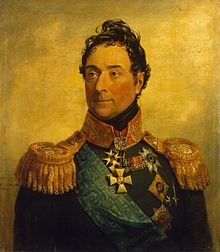(1763-1831) Russian general and corps commander.
He was born Louis Alexander Andrault, chevalier comte de Langéron (to mention but one of many other aristocratic titles) and enlisted at the age of fifteen as a sous-lieutenant in the French Guards (Gardes Français). He later served at Caracas and St. Domingue in 1782-1783. In 1786 he was promoted to assistant colonel of the regiment of Médoc and then colonel of the Armagnac Regiment in 1788. He accompanied the Prince of Nassau to Russia in 1789 and the next year entered Russian service as a colonel in the Siberia Grenadier Regiment. Langeron distinguished himself in the campaigns against the Swedes, especially at Bjork, and commanded the Russian left wing in the battle at Rochensalmi. In 1790-1791, he fought the Turks at Ismail, where he was wounded, and at Macin.
With Catherine II’s permission, Langeron served in the army of Feldmarschall Friedrich Graf Saxe-Coburg-Saalfeld (generally known as Saxe-Coburg) against the French in the Austrian Netherlands (now Belgium and Luxembourg), and, on his return to Russia, he was sent as a military observer to the Austrian army in northern France and Flanders in 1793-1794. In August 1795 he transferred to the Malorossiisk (Little Russia) Grenadier Regiment and rose to brigadier in July 1796. He became a major general and chef of the Ufa (Ufimsky) Musketeer Regiment in June 1797. Under Tsar Paul, Langeron was conferred the title of Count of the Russian Empire. He was given the rank of lieutenant general in November 1798 and appointed chef of the Riga (Ryazhsky) Musketeer Regiment in May 1799. Langeron became the head of the Brest Inspection in August 1800.
Langeron took part in the campaign of 1805 against Napoleon and commanded Russian troops on the Allied left flank at Austerlitz. He was one of the two generals disgraced after the War of the Third Coalition and was sent to Odessa. In 1806-1811, he served in the (Russian) Army of Moldavia against the Ottomans in the Russo-Turkish War. He fought at Giurgiu, Silistra, Frasin, Derekoy, and Ruse. Langeron took command of the 22nd Division in August 1810 and temporarily commanded the Army of Moldavia after General Nikolay Kamenski’s death. He participated in the decisive battle at Ruse in 1811 for which he was promoted to general of infantry in September 1811. In 1812 Langeron commanded the 1st Corps of the Army of the Danube and took part in the actions at Brest-Litovsk and on the Berezina.
During the campaign in Germany in 1813, Langeron was in charge of the blockade of Thorn and later commanded a corps, with which he participated in various engagements, major and minor, including Königswarte, Bautzen, Zibeneichen, Lowenberg, Holdberg, the Katzbach, Hartau, Bischofsward, and Leipzig. In 1814 he led his corps at Soissons, Craonne, Laon, Rheims, La- Fere-Champenoise, and Montmartre. In late 1814 Langeron commanded the 4th and 6th Corps in Volhynia and marched toward the French frontier during the Hundred Days. He had reached the Rhine when Napoleon was defeated at Waterloo and therefore turned back for Russia.
After the war, Langeron was appointed military governor of Kherson and Odessa; commander in chief of the Bug and Black Sea Cossack Hosts; and governor of the Ekaterinoslavl, Kherson, and Tavrida gubernias (provinces) on 28 November 1815. He fought in numerous actions during the Russo-Turkish War of 1828-1829. He died as a result of the cholera epidemic that struck in St. Petersburg in 1831.
References and further reading Izzapisok grafa A. F. Lanzherona, Russkii Arkhiv. 1895. No. 3. St. Petersburg: N. p. Langeron, A. 1998. Journal inédit de la campagne de 1805. Paris: La Vouivre. Zapiski grafa Lanzherona. Voina s Turtsiei v 1806-1812 gg. Russkaia Starina. [1907] No. 7; [1908] Nos. 4-6; [1910] Nos. 7-10; [1911] Nos. 7-8. St. Petersburg: N. p.
